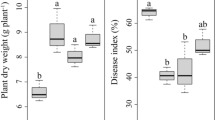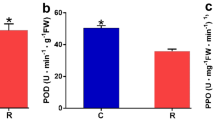Abstract
Aims
Although intercropping and pathogen invasion can affect the plant rhizosphere bacterial community, how intercropping affects the rhizosphere bacterial community in response to pathogen invasion is poorly understood.
Methods
The root system of watermelon was separated into two halves and placed in separate pots for Fusarium oxysporum f. sp. niveum(FON) inoculation and wheat intercropping. Responses of the watermelon rhizosphere bacterial community to wheat intercropping and FON inoculation were analyzed by high-throughput sequencing.
Results
Wheat intercropping did not affect the diversity but altered the composition of rhizosphere bacterial community on both sides of watermelon roots. In watermelon monoculture, FON inoculation increased the diversity of the rhizosphere bacterial community and stimulated certain potentially plant beneficial bacteria. The effects of FON inoculation on the watermelon rhizosphere bacterial community diversity and composition in watermelon-wheat intercropping were weaker than those in watermelon monoculture. No contact between wheat and FON was required to decrease the disease index of Fusarium wilt.
Conclusions
The effects of wheat intercropping and FON inoculation on the watermelon rhizosphere bacterial community were mostly plant-mediated, and under FON invasion the rhizosphere bacterial community was more stable in watermelon-wheat intercropping than in watermelon monoculture.









Similar content being viewed by others
Data availability
The data set was deposited in the NCBI-Sequence Read Archive with the submission accession numbers SRR8755480–8755506.
Abbreviations
- RA:
-
Relative abundance
- FON:
-
Fusarium oxysporum f. sp. niveum
References
Bais HP, Weir TL, Perry LG, Gilroy S, Vivanco JM (2006) The role of root exudates in rhizosphere interactions with plants and other organisms. Annu Rev Plant Biol 57:233–266. https://doi.org/10.1146/annurev.arplant.57.032905.105159
Bardgett RD, van der Putten WH (2014) Belowground biodiversity and ecosystem functioning. Nature 515:505. https://doi.org/10.1038/nature13855
Berendsen RL, Pieterse CMJ, Bakker PAHM (2012) The rhizosphere microbiome and plant health. Trends Plant Sci 17(8):478–486. https://doi.org/10.1016/j.tplants.2012.04.001
Berendsen RL, Vismans G, Yu K, Song Y, de Jonge R, Burgman WP, Rurmolle M, Herschend J, Bakker PAHM, Pieterse CMJ (2018)Disease-induced assemblage of a plant-beneficial bacterial consortium. ISME J 12:1496–1507. https://doi.org/10.1038/s41396-018-0093-1
Caporaso JG, Kuczynski J, Stombaugh J et al (2010) QIIME allows analysis of high-throughput community sequencing data. Nat Methods 7:335–336. https://doi.org/10.1038/nmeth.f.303
Carvalhais LC, Dennis PG, Badri DV, Kidd BN, Vivanco JM, Schenk PM (2015) Linking jasmonic acid signaling, root exudates, and rhizosphere microbiomes. Mol Plant-Microbe Interact 28:1049–1058. https://doi.org/10.1094/mpmi-01-15-0016-r
Chapelle E, Mendes R, Bakker PAHM, Raaijmakers JM (2015) Fungal invasion of the rhizosphere microbiome. ISME J 10:265. https://doi.org/10.1038/ismej.2015.82
Cong W, van Ruijven J, Mommer L, de Deyn G, Berendse F, Hoffland E (2014) Plant species richness promotes soil carbon and nitrogen stocks in grasslands without legumes. J Ecol 102:1163–1170. https://doi.org/10.1111/1365-2745.12280
Coombs JT, Michelsen PP, Franco CMM (2004) Evaluation of endophytic actinobacteria as antagonists of Gaeumannomyces graminis var. tritici in wheat. Biol Control 29:359–366. https://doi.org/10.1016/j.biocontrol.2003.08.001
Derakhshani H, Tun HM, Khafipour (2016) An extended single-index multiplexed 16S rRNA sequencing for microbial community analysis on MiSeq illumina platforms. J Basic Microbiol 56:321–326. https://doi.org/10.1002/jobm.201500420
Edgar RC (2013) UPARSE: highly accurate OTU sequences from microbial amplicon reads. Nat Methods 10:996–998. https://doi.org/10.1038/nmeth.2604
Eisenhauer N, Milcu A, Sabais ACW, Bessler H, Brenner J, Engels C, Klarner B, Maraun M, Partsch S, Roscher C, Schonert F, Temperton VM, Thomisch K, Weigelt A, Weisser WW, Scheu S (2011) Plant diversity surpasses plant functional groups and plant productivity as driver of soil biota in the long term. PLoS One 6:e16055. https://doi.org/10.1371/journal.pone.0016055
Eisenhauer N, Dobies T, Cesarz S, Hobbie SE, Meyer RJ, Worm K, Reich PB (2013) Plant diversity effects on soil food webs are stronger than those of elevated CO2 and N deposition in a long-term grassland experiment. Proc Natl Acad Sci U S A 110:6889–6894. https://doi.org/10.1073/pnas.1217382110
El-Abyad MS, El-Sayed MA, El-Shanshoury AR, El-Sabbagh SM (1993) Towards the biological control of fungal and bacterial diseases of tomato using antagonistic Streptomyces spp. Plant Soil 149:185–195. https://doi.org/10.1007/bf00016608
Gardes M, Bruns TD (1993) ITS primers with enhanced specificity for basidiomycetes--application to the identification of mycorrhizae and rusts. Mol Ecol 2:113–118. https://doi.org/10.1111/j.1365-294X.1993.tb00005.x
Ghorbani R, Wilcockson S, Koocheki A, Leifert C (2008) Soil management for sustainable crop disease control: a review. Environ Chem Lett 6:149–162. https://doi.org/10.1007/s10311-008-0147-0
Gu Y, Wei Z, Wang X, Friman V-P, Huang J, Wang X, Mei X, Xu Y, Shen Q, Jousset A (2016) Pathogen invasion indirectly changes the composition of soil microbiome via shifts in root exudation profile. Biol Fertil Soils 52:997–1005. https://doi.org/10.1007/s00374-016-1136-2
Haichar FEZ, Santaella C, Heulin T, Achouak W (2014) Root exudates mediated interactions belowground. Soil Biol Biochem 77:69–80. https://doi.org/10.1016/j.soilbio.2014.06.017
Harvás A, Landa B, Jiménez-Díaz RM (1997) Influence of chickpea genotype and Bacillus sp. on protection from Fusarium wilt by seed treatment with nonpathogenic Fusarium oxysporum. Eur J Plant Pathol 103:631–642. https://doi.org/10.1023/a:1008658209966
Hedlund K, Regina S, van der Puttrn W, Leps J, Diaz T, Korthals G, Lavorel S, Brown V, Gormsen D, Mortimer S, Rodriguez Barrueco C, Roy J, Smilauer P, Smilauerova M, van Dijk C (2003) Plant species diversity, plant biomass and responses of the soil community on abandoned land across Europe: idiosyncracy or above-belowground time lags. Oikos 103(1):45–58. https://doi.org/10.1034/j.1600-0706.2003.12511.x
Hollister E, Hu P, Wang A, Hons F, Gentry T (2013) Differential impacts of brassicaceous and nonbrassicaceous oilseed meal on soil bacterial and fungal communities. FEMS Microbiol Ecol 83(3):632–641. https://doi.org/10.1111/1574-6941.12020
Inderbitzin P, Ward J, Barbella A, Solares N, Izyumin D, Burman P, Chellemi DO, Subbarao KV (2017) Soil microbiomes associated with Verticilliumwilt-suppressive broccoli and chitin amendments are enriched with potential biocontrol agents. Phytopathology 108:31–43. https://doi.org/10.1094/phyto-07-17-0242-r
Jousset A, Rochat L, Lanoue A, Bonkowski M, Keel C, Scheu S (2011) Plants respond to pathogen infection by enhancing the antifungal gene expression of root-associated bacteria. Mol Plant-Microbe Interact 24:352–358. https://doi.org/10.1094/MPMI-09-10-0208
Li L, Zhang F, Li X, Christie P, Sun J, Yang S, Tang C (2003) Interspecific facilitation of nutrient uptake by intercropped maize and faba bean. Nutr Cycl Agroecosyst 65:61–71. https://doi.org/10.1023/A:1021885032241
Li L, Tilman D, Lambers H, Zhang F (2014) Plant diversity and overyielding: insights from belowground facilitation of intercropping in agriculture. New Phytol 203(1):63–69. https://doi.org/10.1111/nph.12778
Li X, de Boer W, Zhang Y, Ding C, Zhang T, Wang X (2018) Suppression of soil-borneFusarium pathogens of peanut by intercropping with the medicinal herb Atractylodes lancea. Soil Biol Biochem 116:120–130. https://doi.org/10.1016/j.soilbio.2017.09.029
Li C, Fu X, Zhou X, Liu S, Xia Y, Li N, Zhang X, Wu F (2019) Treatment with wheat root exudates and soil microorganisms from wheat/watermelon companion cropping can induce watermelon disease resistance against Fusarium oxysporum f. sp. Niveum. Plant Dis 103:1693–1702. https://doi.org/10.1094/PDIS-08-18-1387-RE
Lv H, Cao H, Nawaz MA, Sohail H, Huang Y, Cheng F, Kong Q, Bie Z (2018) Wheat intercropping enhances the resistance of watermelon to Fusarium wilt. Front Plant Sci 9:696. https://doi.org/10.3389/fpls.2018.00696
Marschner P, Baumann K (2003) Changes in bacterial community structure induced by mycorrhizal colonisation in split-root maize. Plant Soil 251:279–289. https://doi.org/10.1023/a:1023034825871
McCann K (2000) The diversity-stability debate. Nature 405(6783):228–233. https://doi.org/10.1038/35012234
Ren L, Su S, Yang X, Xu Y, Huang Q, Shen Q (2008) Intercropping with aerobic rice suppressed Fusarium wilt in watermelon. Soil Biol Biochem 40:834–844. https://doi.org/10.1016/j.soilbio.2007.11.003
Schlatter DC, Bakker MG, Bradeen JM, Kinkel LL (2015) Plant community richness and microbial interactions structure bacterial communities in soil. Ecology 96:134–142. https://doi.org/10.1890/13-1648.1
Schlatter DC, Kinkel LL, Thomashow L, Weller D, Paulitz T (2017) Disease suppressive soils: new insights from the soil microbiome. Phytopathology 107:1284–1297. https://doi.org/10.1094/PHYTO-03-17-0111-RVW
Song Y, Zhang F, Marschner P, Fan F, Gao H, Bao X, Sun J, Li L (2007) Effect of intercropping on crop yield and chemical and microbiological properties in rhizosphere of wheat (Triticum aestivum L.), maize (Zea mays L.), and faba bean (Vicia faba L.). Biol Fertil Soils 43:565–574. https://doi.org/10.1007/s00374-006-0139-9
van Elsas JD, Chiurazzi M, Mallon CA, Elhottovā D, Krištůfek V, Salles JF (2012) Microbial diversity determines the invasion of soil by a bacterial pathogen. Proc Natl Acad Sci U S A 109:1159–1164. https://doi.org/10.1073/pnas.1109326109
Viketoft M, Bengtsson SB, Berg M, Petchey O, Palmborg C, Huss-Danell K (2009)Long-term effects of plant diversity and composition on soil nematode communities in model grassland. Ecology 90(1):90–99. https://doi.org/10.1890/08-0382.1
Vyas P (2018) Endophytic microorganisms as bio-inoculants for sustainable agriculture. In: Vyas P (ed) Microbial bioprospecting for sustainable development. Springer, Berlin, pp 41–60
Wang Q, Garrity GM, Tiedje JM, Cole JR (2007) Naive bayesian classifier for rapid assignment of rRNA sequences into the new bacterial taxonomy. Appl Environ Microbiol 73:5261–5267. https://doi.org/10.1128/aem.00062-07
Wardle DA (2006) The influence of biotic interactions on soil biodiversity. Ecol Lett 9:870–886. https://doi.org/10.1111/j.1461-0248.2006.00931.x
Weber OB, Muniz CR, Vitor AO, Freire FCO, Oliveira VM (2007) Interaction of endophytic diazotrophic bacteria and Fusarium oxysporum f. sp. cubense on plantlets of banana ‘Maça’. Plant Soil 298:47–56. https://doi.org/10.1007/s11104-007-9335-0
Wei Z, Yang T, Friman V-P, Xu Y, Shen Q, Jousset A (2015) Trophic network architecture of root-associated bacterial communities determines pathogen invasion and plant health. Nat Commun 6:8413. https://doi.org/10.1038/ncomms9413
Wei Z, Hu J, Ya G, Yin S, Xu Y, Jousset A, Shen Q, Friman V-P(2018)Ralstonia solanacearum pathogen disrupts bacterial rhizosphere microbiome during an invasion. Soil Biol Biochem 118:8–17. https://doi.org/10.1016/j.soilbio.2017.11.012
Xu W, Liu D, Wu F, Liu S (2015a) Root exudates of wheat are involved in suppression of Fusarium wilt in watermelon in watermelon-wheat companion cropping. Eur J Plant Pathol 141:209–216. https://doi.org/10.1007/s10658-014-0528-0
Xu W, Wang Z, Wu F (2015b) The effect of D123 wheat as a companion crop on soil enzyme activities, microbial biomass and microbial communities in the rhizosphere of watermelon. Front Microbiol 6:899. https://doi.org/10.3389/fmicb.2015.00899
Zhang Z, Zhang J, Wang Y, Zheng X (2005) Molecular detection of Fusarium oxysporum f. sp. Niveum and Mycosphaerella melonisin infected plant tissues and soil. FEMS Microbiol Lett 249:39–47. https://doi.org/10.1016/j.femsle.2005.05.057
Zhou X, Yu G, Wu F (2011) Effects of intercropping cucumber with onion or garlic on soil enzyme activities, microbial communities and cucumber yield. Eur J Soil Biol 47:279–287. https://doi.org/10.1016/j.ejsobi.2017.07.001
Zhou X, Liu J, Wu F (2017) Soil microbial communities in cucumber monoculture and rotation systems and their feedback effects on cucumber seedling growth. Plant Soil 415:507–520. https://doi.org/10.1007/s11104-017-3181-5
Zhou Q, Chen J, Xing Y, Xie X, Wang L (2019) Influence of intercropping Chinese milk vetch on the soil microbial community in rhizosphere of rape. Plant Soil 440:85–97. https://doi.org/10.1007/s11104-019-04040-x
Acknowledgments
This work was supported by the National Key Research and Development Program of China (2018YFD1000800), the National Natural Science Foundation of China (31471917), and the Natural Science Foundation of Heilongjiang Province (YQ2019C009).
Author information
Authors and Affiliations
Contributions
Fengzhi Wu and Xingang Zhou designed the study. Hongjie Yu and Xiaoxiao Zhang performed the experiments. Hongjie Yu and Shaocan Chen analyzed the data and wrote the manuscript.
Corresponding authors
Ethics declarations
Conflict of interest
The authors declare that they have no conflict of interest.
Additional information
Responsible Editor: Ian Dodd.
Publisher’s note
Springer Nature remains neutral with regard to jurisdictional claims in published maps and institutional affiliations.
Electronic supplementary material
ESM 1
(DOC 919 kb)
Rights and permissions
About this article
Cite this article
Yu, H., Chen, S., Zhang, X. et al. Rhizosphere bacterial community in watermelon-wheat intercropping was more stable than in watermelon monoculture system under Fusarium oxysporum f. sp. niveum invasion. Plant Soil 445, 369–381 (2019). https://doi.org/10.1007/s11104-019-04321-5
Received:
Accepted:
Published:
Issue Date:
DOI: https://doi.org/10.1007/s11104-019-04321-5




